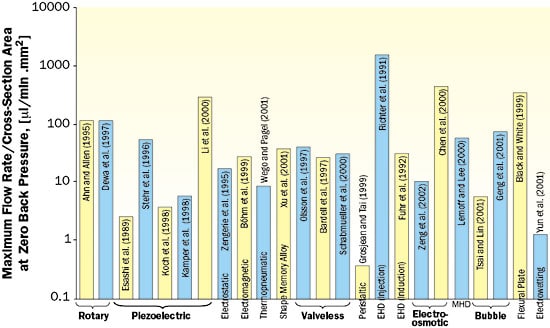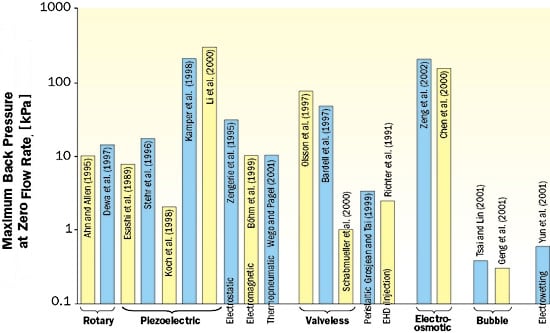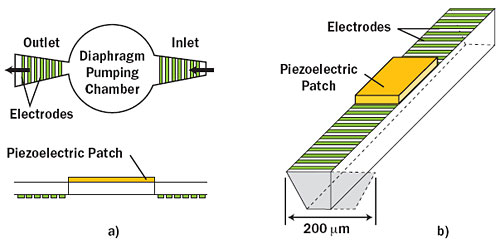Introduction
Traditional cooling approaches, consisting typically of external air-cooled heat sinks, are increasingly falling short in meeting the thermal management challenges of emerging electronic systems. Integrated cooling designs are being investigated to eliminate some of the interface contact resistances introduced by add-on heat sinking and to minimize package volume.
Forced convective liquid cooling through microchannel heat sinks is among the more promising technologies that have been proposed for achieving very high heat removal rates; critically, this technology is amenable to on-chip integration [1]. However, the pressure heads encountered in microchannel heat sinks can be very high [2] and require the use of a sizeable external pump to drive the flow. Conventional rotary pumps are unsuitable for this purpose due to their large size and power consumption, especially for personal computers and mobile electronic devices. In response to this critical need, novel pumping strategies, which have been miniaturized to sub-millimeter dimensions, have been developed in the last two decades. These ‘micropumps’ offer significant advantages for future electronics cooling applications, as they are much smaller in size than conventional pumps and can be potentially integrated into the microchannels.
A comprehensive review of microscale pumping technologies for liquid cooling systems has been conducted [3] based on quantitative and qualitative evaluation criteria for applicability in microchannel heat sinking. The differences between fluid mechanics at the macro- and micro-length scales, arising from different scaling of forces affecting the flow, are explored in [4,5]. Models for liquid and gas flows are discussed along with various applications of Micro-Electro-Mechanical Systems (MEMS) in fluid mechanics, particularly in flow and turbulence control.
Micropumps for microchannel heat sinks used in electronics cooling typically would require both high flow rates to meet the high heat flux needs, as well as large pressure heads to overcome the pressure drop. An assessment of the existing micropump designs in the literature found that they do not simultaneously meet both these demands [6]. Several challenges exist in designing micropumps to achieve both high flow rates and high pressure drops. Flow physics at the small scales encountered are yet to be fully understood. Since various forces affecting fluid flow and pump operation scale at different rates with device size, their relative magnitudes at small scales can be considerably different from those at larger scales.
The true promise of micropumps lies in their potential for integration into microchannel heat sinks. Because an individual micropump may not be able to generate sufficient pressure head and flow rate, a number of micropumps in an array or along the length of a channel may need to be used. The entire microchannel cooling system can then be integrated directly onto the chip. Specifically, the cooling channels could be etched directly onto the backside of the silicon substrate used for active devices. Since the micropump components can be integrated directly into cooling channels, the resulting flow loop would contain only the active silicon device (including integrated micropumps and channels) and an external heat exchanger. This would greatly simplify traditional flow loops characterized by large pumps, heat exchangers and heat sinks, all separate from the active device. Moreover, the size reduction achieved with the micropump is in itself very significant, even if it were not integrated into the chip. The resulting chip-integrated microchannel cooling and pumping system could dissipate heat fluxes of the order of 100 W/cm2 with the potential for further increases through design improvements.
Review of Microscale Pumping Technologies
A review of the state of the art with respect to micropumping approaches for driving fluid through microchannels is presented in [3] with a particular emphasis on small-scale cooling applications. The physical principles, engineering limitations and advantages of micropumps discussed in the literature are included; a quantitative comparison is provided in terms of the maximum achievable flow rate per unit cross-sectional area of the microchannel and the maximum achievable back pressure. The micropumps are also compared according to criteria such as miniaturization potential, size, actuation voltage and power required per unit flow rate, ease and cost of fabrication, minimum and maximum frequency of operation, and suitability to electronics cooling.
The micropumps considered are broadly classified according to their pumping mechanisms into the following categories:
- Mechanical micropumps, including rotary pumps, vibrating diaphragms, and peristaltic micropumps
- Electrokinetic and magnetokinetic micropumps, including electrohydrodynamic (EHD), electroosmotic, and magnetohydrodynamic (MHD) micropumps
- Phase change micropumps, including bubble pumps and electrochemical pumps
- Other/novel micropumps, such as flexural plate wave devices and electrowetting micropumps
Micropumps in any of the above categories can be further classified into sub-categories, for example, the vibrating diaphragm and peristaltic micropumps can be divided based on their actuation principle, i.e., piezoelectric, electrostatic, or thermopneumatic. Vibrating diaphragm micropumps can also be classified based on the type of valve mechanism used, and EHD micropumps can be classified as induction, injection, or polarization type.
Comparison of Microscale Pumping Technologies
A quantitative comparison of the various micropumps for which quantitative descriptions were available is presented in [3]. The pumps are compared based on their maximum reported flow rate per unit area, maximum achievable back pressure, voltage, power input, and frequency of operation for peak performance. To illustrate the potential of different pumps graphically, the maximum flow rates per unit area as well as the maximum back pressure are plotted in Figures 1a and 1b, respectively, for the pumps reviewed in [3]. In general, the pumping techniques using surface effects, such as electroosmosis and flexural plate waves, perform better in terms of flow rate per unit area. However, these pumps use very shallow channels to maximize surface forces. On the other hand, in a microchannel cooling system, channel depths would be much larger and surface effects not as dominant.
 |
 |
Figure 1. (a) Maximum flow rate per unit cross-sectional area at zero back pressure, and (b) maximum back pressure at zero flow rate for various micropumps in the literature [3].Among the micropumps in the literature, the highest pressure heads were reported for vibrating diaphragm micropumps with check valves, electroosmotic pumps, and valveless micropumps using nozzle-diffuser elements, in this order, (see also Figure 1b). If the power input to the micropump is a constraint, electrowetting micropumps are ideal because they have the lowest power requirement per unit flow rate. Vibrating diaphragm micropumps using electrostatic actuation also have low power requirements. Moreover, vibrating diaphragm pumps operating specifically at the resonant frequency of the system have the potential to achieve very high flow rates per unit power input.
Detailed quantitative comparison tables are provided in [3] and include comparisons of flow rate, maximum back pressure, size, and power, among other parameters. The use of flow rate per unit area in the comparisons eliminates the confounding effect of pump size on the flow rate comparison. Applicable surface area, the inclusion or exclusion of fluidic connections, and selected cross-sectional areas are outlined in [3].
The micropumps are also compared based on qualitative features, such as the ability to pump different liquids, type and ease of the fabrication method used, and other advantages and disadvantages of these pumps, which render them suitable or unsuitable for certain applications. The miniaturization potential of different pumps has been estimated. In addition, their suitability for electronics cooling with respect to their use of heat, or electric or magnetic fields, as part of the actuation mechanism is reported, since these may interfere with the proper functioning of electronic devices or may alter its applicability for cooling. However, it is possible to isolate the electronics from imposed magnetic/electric fields in a relatively straightforward manner, and designs can be envisioned for various bubble pumps and thermopneumatically actuated pumps where the heat from the chips could be used for actuation.
The comparison of different micropumps leads to a number of conclusions with respect to the suitability of various micropumping techniques proposed in the literature under specific constraints. Pumps with the highest flow rates per unit area are the nozzle-diffuser micropumps with piezoelectric actuation, injection-type EHD pumps, electroosmotic micropumps, and flexural plate wave pumps. However, most pump designs have not been rigorously optimized, and with design improvements, rotary pumps and other actuation schemes, such as shape memory alloys, also have the potential to achieve high flow rates. In particular the optimal microchannel widths for integrated electronics cooling applications are known to be in the range of 50 to 100 �m, with channel aspect ratios of 4 to 6 [7,8]. Nozzle-diffuser and EHD micropumps are therefore best suited for this application because they have good miniaturization potential and use body forces instead of surface effects for actuation. However, if much smaller microchannel dimensions (~5-10 �m) were to be used, surface forces may start to dominate volume forces, and surface force-based pumping mechanisms, such as electroosmotic, flexural plate waves, and electrowetting pumping, may become more suitable. In particular, electroosmotic micropumps can be attractive because of the high back pressures achievable as well as their simple structure and lack of moving parts.
Novel Micropump Design
Based on the review of the existing micropump designs, a new micropump concept has been proposed by the authors. This concept involves a combined vibrating diaphragm pump with induction-type EHD actuation for flow rectification [9]. From this study and subsequent investigations, it has been discovered that the efficiency of EHD pumping depends strongly on the bulk fluid velocity [10]. For flow due to a constant, stationary potential gradient, the efficiency of EHD pumping increases monotonically with an increase in the bulk fluid velocity. Moreover, the total fluid power output from the combined action of EHD and an externally imposed pressure gradient is larger than the sum of fluid power outputs from their action independent of each other. By adding a vibrating diaphragm to enhance the fluid velocity near the wall, the efficiency of EHD pumping is increased and a higher net pumping power achieved.
 |
Figure 2. Schematic representation of preliminary micropump designs (a) with, and (b) without nozzle-diffuser elements.Schematic diagrams of the preliminary micropump designs are shown in Figure 2. Heat flux from the chip is applied along the bottom of the channel. Since the channels can be fabricated directly in a silicon substrate, contact resistance is eliminated. A temperature gradient normal to fluid flow direction is established in such a configuration as is necessary for ion induction. The nozzle-diffuser elements have been eliminated in the most recent designs for easier fabrication, without significant reduction in total flow through microchannel arrays.
Experimentally validated numerical simulations indicate promising results for this novel micropump design. For the micropump design shown in Figure 2b, with six channels in parallel (channel width = 200 �m, fin width = 50 �m, channel length = 1500 �m, area = 2.25 mm2), numerical calculations predict a total flow rate of 63 �L/min. For a 20 K mean fluid temperature rise along the pump length, this implies a heat removal rate of 86.7 mW for a power input of merely 7.28 �W. Significant improvements in heat flux are expected to result from the use of a larger diaphragm and a denser array of electrodes. A prototype chip-integrated micropump array is currently being developed.
References
- Garimella, S.V., Singhal, V., and Liu, D. “On-chip thermal management with microchannel heat sinks and integrated micropumps,” Proceedings of the IEEE (in press).
- Garimella, S.V., and Sobhan, C.B., 2003, “Transport in microchannels – A critical review,” Annual Review of Heat Transfer, Vol. 13, pp. 1-50.
- Singhal, V., Garimella, S.V., and Raman, A., 2004, “Microscale pumping technologies for microchannel cooling systems,” Applied Mechanics Reviews, Vol. 57, pp. 191-221.
- Ho, C.M., and Tai, Y.C., 1998, “Micro-electro-mechanical systems (MEMS) and fluid flows,” Annual Review of Fluid Mechanics, Vol. 30, pp. 579-612.
- Gad-el-Hak, M., 1999, “The fluid mechanics of microdevices – The Freeman scholar lecture,” Journal of Fluids Engineering, Vol. 121, pp. 5-33.
- Singhal, V., Liu, D., and Garimella, S.V., “Analysis of micropumping requirements for microchannel cooling systems,” InterPACK 2003-35237, Maui, Hawaii, July 6-11, 2003.
- Tuckerman, D.B., and Pease, R.F.W., 1981, “High performance heat sinking for VLSI,” IEEE Electron Device Letters, Vol. EDL-2, pp. 126-129.
- Weisberg, A., Bau, H.H., and Zemel, J.N., 1992, “Analysis of microchannels for integrated cooling,” International Journal of Heat and Mass Transfer, Vol. 35, pp. 2465-2474.
- Singhal, V., and Garimella, S.V., 2005, “A novel valveless micropump with electrohydrodynamic enhancement for high heat flux cooling,” IEEE Transactions on Advanced Packaging, Vol. 28, pp. 216-230.
- Singhal, V., and Garimella, S.V., 2005, “Influence of bulk fluid velocity on the efficiency of electrohydrodynamic pumping,” Journal of Fluids Engineering, Vol. 127, pp. 484-494.




